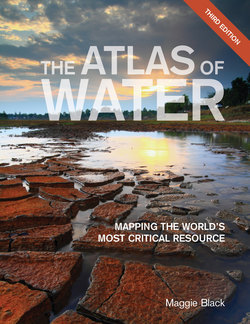Читать книгу The Atlas of Water - Maggie Black - Страница 16
На сайте Литреса книга снята с продажи.
ОглавлениеPart 1
A Finite Resource
Water, fundamental to all life and human activity, is under serious threat. This is not because the supply is dwindling significantly – although some aquifers containing irreplaceable fossil water are being exhausted. The renewable supply of water on which planetary survival and well-being depend remains constant. Moisture evaporated by the sun from seas, soil and vegetation is released as rain to nourish plant growth and fill rivers, lakes and underground aquifers. Climate change may be influencing the localized behaviour and impacts of this “hydrological cycle”, but this is not the most immediate threat. Water falls unevenly in different latitudes and terrains, but there ought to be enough to meet humanity’s needs. The problem lies in the way its consumption per head has been rising much faster than population growth. An increasing number of people with industrialized lifestyles consume diets rich in foodstuffs needing extra water to produce, and demand goods such as cars, television sets and computers whose manufacture also requires large volumes of water. This places excessive demands on vulnerable sources, stretching the available supply to its physical limits – especially in less well-endowed regions such as the Middle East. The ability to control water and manage its use for productive purposes has always been central to human and economic development. Leaders of the ancient world depended on hydraulic works – dams, lifting devices and artificial lakes – to develop and maintain their civilizations. They fully understood the variability of rainfall and run-off that constituted the universal freshwater problem, long before today’s pressures had to be taken into account. Those living in water-short areas or those with seasonal rains tackle their problems by capturing run-off behind dams, and storing or diverting water for agricultural or other uses. As more water is manipulated in this way, the environmental and other limits of this approach have become apparent. Upstream and downstream users of the same resource, in river basins and watersheds, are forced into dispute as populations grow and demands increase. However unevenly distributed, the supplies provided by natural forces are going to have to suffice. New ways of managing water will have to be found in order to maintain quantity and quality and achieve a fair distribution of a substance essential to life on Earth.
19
